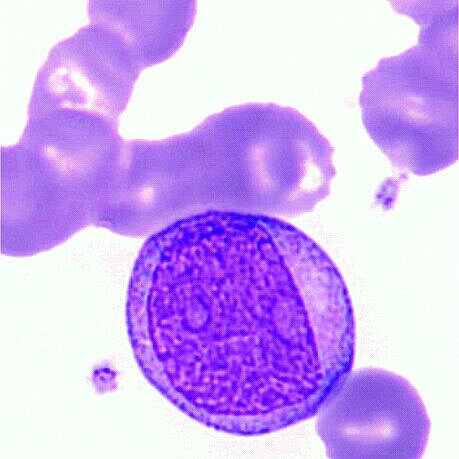Haematopoiesis
Haematopoiesis is the process by which uncommitted haematopoietic stem cells proliferate and differentiate into all the cellular components of the blood. The pluripotent stem cell can develop into all types of blood cells by going through several steps to ultimately become a red blood cell, platelet, or white blood cell.
Using a fresh optical approach, our interactive haematopoiesis graphic illustrates this development from the pluripotent stem cell via progenitor and precursor cells in bone marrow, lymph nodes and thymus to the mature blood cells circulating in peripheral blood. Click on any cell image to display some short information on the respective cell type.
The sites of haematopoiesis
In adults, more than 95% of haematopoiesis takes place in bone marrow. With ageing, the increase in yellow marrow restricts the sites of haematopoiesis to the axial skeleton and proximal ends of long bones (e.g. femur and humerus). In the presence of defective or insufficient haematopoiesis in bone marrow, expansion of the red marrow may occur. Under certain conditions, the liver or spleen can also act as haematopoietic organs (‘extra-medullary haematopoiesis’).
The regulation of haematopoiesis
The biology behind normal haematopoiesis is rather complex, involving extensive coordination of numerous molecular programs involved in cell division and the determination of cell fate. The regulation of haematopoiesis is dependent on glycoprotein growth factors which drive the proliferation and differentiation of progenitor cells. Growth factors include for example erythropoietin (EPO), thrombopoietin (TPO), interleukins (e.g. IL-3, IL-6, IL-7, IL-11) and colony-stimulating factors (e.g. M-CSF, G-CSF). As negative regulators, TNF-alpha and TGF-beta are described. The dysregulation of haematopoiesis may lead to deficiencies (e.g. anaemia, leucocytopenia, thrombocytopenia) or over-production (e.g. haematological malignancies).
The role of a haematology analyser in detecting the haematopoietic status
Immature haematopoietic precursors can be identified and quantified by fluorescence flow cytometry employed by the XN-Series and partly XN-L Series analysers and are expressed in the following parameters: nucleated red blood cells (NRBC), immature granulocytes (IG), reticulocytes, immature platelets (IPF) and haematopoietic progenitor cells (HPC). Monitoring these parameters provides information about bone marrow activity directly from a measurement of whole blood.
Haematopoietic stem cells, unlike embryonic stem cells, can be collected from the peripheral blood by apheresis after mobilisation. XN technology can also support in optimising these procedures.
![Haematopoesis Solarsystem [.DK-dk Denmark (danish)] Our haematopoiesis poster illustrates the development from the pluripotent stem cell via progenitor and precursor cells in bone marrow, lymph nodes and thymus to the mature blood cells circulating in peripheral blood, using a fresh optical approach.](/fileadmin/_processed_/1/f/csm_Haematopoesis_Solarsystem_Poster_12d1c6ec95.png)



